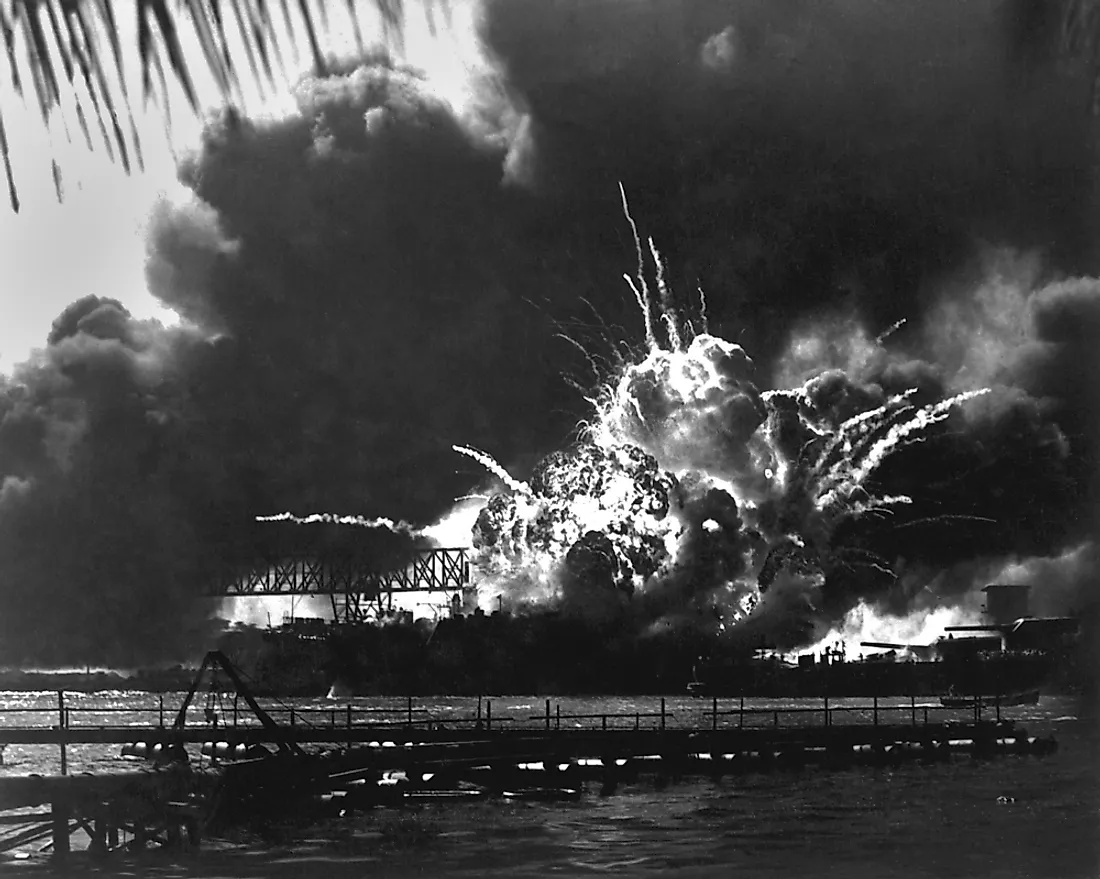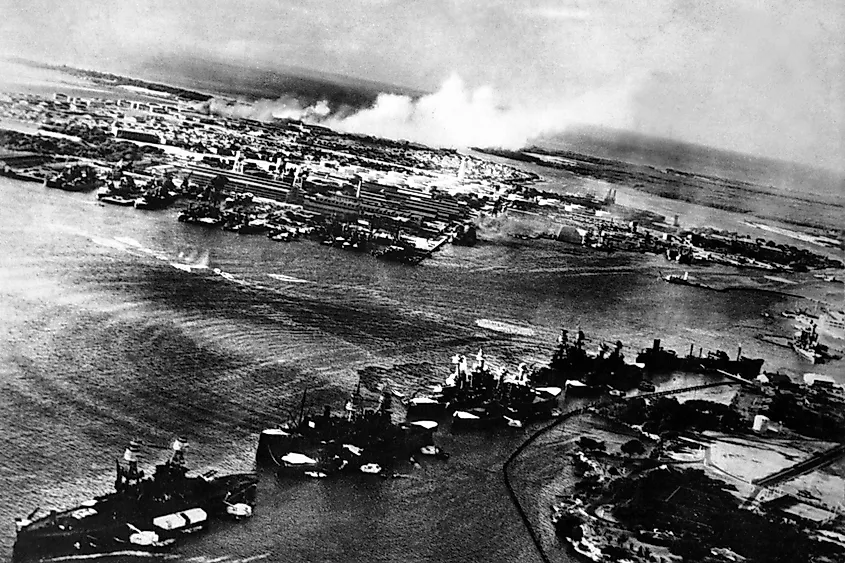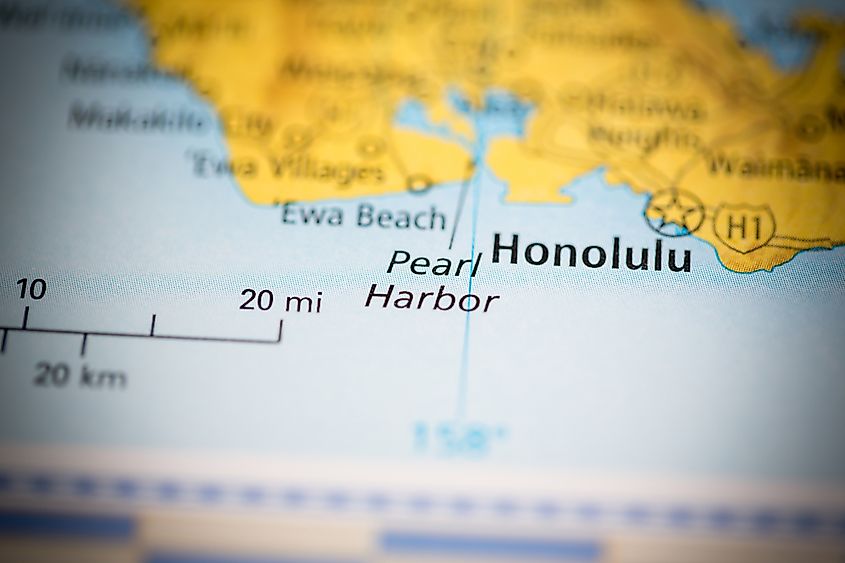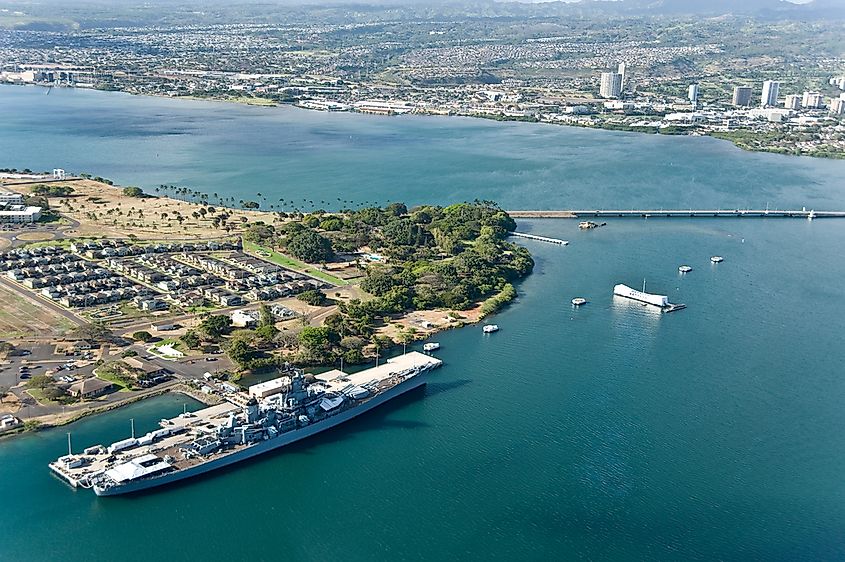The Attack on Pearl Harbor | Map and Description

Pearl Harbor is a military base of the United States military. The base is located next to Honolulu and consists of both the United States Navy Naval Station Pearl Harbor and the United States Air Force Hickam Air Force Base, which were amalgamated in 2010. Pearl Harbor lies in the Pacific Ocean some 2,000 and 4,000 miles from the US and Japan respectively. The attack on Pearl Harbor refers to a surprise military strike on the base by the Imperial Japanese Navy Air Service back on December 6, 1941. The attack bears a crucial significance in the history of the US. After the bombing of Pearl Harbor, the United States joined World War II the next day on December 7, 1941.

A Japanese aerial photo of the Pearl Harbor attacks.
The Japanese called the attacked "Operation Z" during its planning phase while they called the actual attack "Operation AI" and "the Hawaii Operation". The attack itself began in the morning local time and consisted of 353 Japanese aircraft fighters such as torpedo bombers and level and dive-bombers. Germany and Italy also joined the fray and declared war on the US on December 11, which in turn led to the US declaring war against the two entrants. In total, 2,403 Americans died, 1,143 were wounded, at least 10 American naval ships were destroyed, and other significant losses.
Pearl Harbor Background

Since the 1920s, war between the US and Japan was always a possibility even though their relationship was cordial enough. Tensions rose in 1931 when Japan invaded Manchuria and extended its reach over the following decade into China, which eventually started the 1937 Second Sino-Japanese conflict. After that war, public opinion towards Japan in the US changed to the negative after certain events like the Allison incident, the bombing of USS Panay, and the Nanking Massacre. To curb the growing influence of Japan, powers such as France, the UK, and the US assisted China with funds for their war efforts.
When the Japanese invaded French Indochina in 1940 to stop the flow of supplies to China, the US stopped essential shipments such as airplanes and parts to Japan. Unsurprisingly, Japan perceived this act by the US as unfriendly. Despite all the cuts, the flow of oil from the US to Japan did not stop for fear that the Japanese would see it as extremely provocative. A year later, all oil exports finally ceased after Japan seized French Indochina, which prompted the Japanese to move on the Dutch East Indies because of its rich oil reserves. Roosevelt issued an explicit warning on August 17, 1941, that the US was prepared to oppose Japan if neighboring countries were affected. The Japanese were left with a conundrum; withdraw from China and suffer the embarrassment or advance anyway.

Pearl Harbor today.
Following the threat from the US, the Japanese attempted peace talks with the US in the same year. Japan offered to leave most of China alone, refrain from trade restrictions and other concessions. The US ambassador to Japan urged Roosevelt to take the deal arguing that it was the only way for peace to prevail. Unfortunately, a number of things happened that prevented peace from prevailing such as the Japanese forces’ refusal from leaving China, the fall of the Japanese government, and Roosevelt refusing to act on his ambassador’s recommendation. The US made a counteroffer on November 26 (27 in Japan) demanding the complete and unconditional withdrawal of Japan from China. A day before in Japan, on 26, before the US demands were delivered, Japanese troops left for Pearl Harbor for a preventive strike to keep the US from interfering.
Planning and Objectives
The plan of the attack started in 1941 under Admiral Isoroku Yamamoto, who commanded the Japanese Combined Fleet. The whole idea was to protect the Japanese interests in the "Southern Resource Area" from American interference. The "Southern Resource Area" was the name the Japanese gave Southeast Asia and the Dutch East Indies. The Japanese went through an extensive planning phase that included training pilots, collecting intelligence, adapting equipment, and other things.
The objectives of the plan included:
- To destroy important fleets of the US military thereby ensuring no interference from the Americans in the conquest of the Southern Resource Area.
- To buy time for the Japanese to regroup and solidify its position before the planned shipbuilding by the US that was set forth in the 1940 Vinson-Walsh Act.
- To reduce the US ability to mobilize its troops in the Pacific Ocean.
- Lastly, the Japanese hoped that the attack would kill the morale of the Americans such that the US would drop its demands.
Despite lengthy planning, the Japanese knew that there were disadvantages to the attack. Key among them was the fact that the Americans would easily salvage the ships since they were anchored in shallow waters. Most of the crew would also be ashore since the ships were anchored, which meant a lot of survivors. In addition, the Japanese ignored nearby points of interests such as the navy yard, a submarine base, and oil tank farms. They ignored these because they though the short and vicious strike would end the war before they had any real effect.
The Attack
The strike force from Japan was composed of two waves each with different objectives and targets. The first wave comprised of 183 planes under the leadership of Commander Mitsuo Fuchida. The first wave included three groups with the first group targeting battleships and aircraft carriers. The second group targeted Ford Island and Wheeler Field while the third targeted Hickam Field, Barber's Point, Wheeler Field, an aircraft at Ford Island, and Kaneohe.
The second wave included 171 planes under the command of Lieutenant-Commander Shigekazu Shimazaki. This wave also consisted of three groups each with its own targets. The initial wave was detected by the US radar but it was dismissed as a training operation by Lieutenant Kermit A. Tyler.
If a certain commander Nagumo listened to his junior officers, then there would have been a third wave. However, Nagumo opted against it since he deemed the risk too great as the Americans had been rallying and organizing after the first wave. However, the Japanese were left fuming after Nagumo withdrew before ordering a third strike since the US rallied quickly and retaliated with devastating effect.
Casualties and Damage
The vicious attack took a total of 90 minutes to devastating effect and damage. The breakdown of the losses is as follows:
- 2,008 sailors dead and 710 wounded
- 218 airmen and soldiers and 364 wounded
- 109 marines dead and 69 wounded
- 68 civilians dead and 35 wounded
- Eighteen ships sunk or run aground
Of the total dead Americans (2403), almost half died because of the explosion from the battleship called Arizona. Most of the casualties were junior officers aged 17 or 18. On the Japanese side, 50 airmen and 9 submariners died and one was captured. The Japanese lost 29 planes while 79 of their planes were damaged.
Aftermath
To sum up the aftermath, Admiral Hara Tadaichi came up with this famous saying; "We won a great tactical victory at Pearl Harbor and thereby lost the war." Another famous quote after the attack came from Roosevelt when he named the day as "a date which will live in infamy". The ensuing World War II saw the fall of the Japanese Empire.











